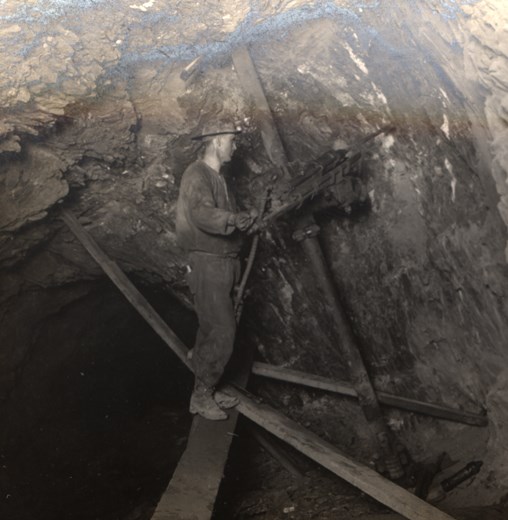Last updated: August 18, 2017
Article
Keweenaw Copper at War

NPS
As World War I entered its second year, the American Institute of Metals trade journal blithely remarked that “[i]t is almost impossible to kill a man in an up-to-date and scientific way without using copper." 1
The journal was right. By 1914, copper had become an essential component of every weapon, vehicle, and piece of equipment used on the battlefield. Its ability to conduct electricity, withstand water, and transmit heat made it ideal for many different applications, as did its malleability and durability. Engineers used copper to improve weapons and develop machines that were far more deadly than those used in previous conflicts, including armored tanks and airplanes. Submarines had increased capacity and range; rifles and machine guns were more accurate than ever before.
At the time, Michigan’s Keweenaw Peninsula was one of the most important copper mining regions in the United States.2 Although it was no longer the country’s leading producer—that distinction shifted to Montana and Arizona mines in the 1880s—Keweenaw copper was highly prized because it was nearly pure, elemental copper, which gave it exceptional conductive qualities. Actively mined over thousands of years by early American Indians, industrial-scale operations began in 1845, and the Keweenaw quickly became the most important copper mining district in the world. Many different companies operated along the mineral range, but they were led by two giants: the Quincy Mining Company (1846), and the Calumet and Hecla Mining Company (merged 1871). Their innovative and unique mining history is commemorated at Keweenaw National Historical Park.

KHSC--Keystone--22034--Miner Drilling Copper Rock with Leyner Machine--Calumet-Hecla Mines--ca. 1910 crop (Keweenaw NHP Archives)
Germany had been the largest importer of American copper before the war, including copper from the Keweenaw. Germany relied on these imports to build its army and navy, including the unprecedented Untersee-boats that sunk merchant and passenger ships in the North Atlantic.3 Trade with Germany ceased in 1914 when France, Britain, and its colonies (including Canada, Australia, and New Zealand) declared war, but exports to these and other Allied nations increased as they expanded their own forces and stockpiled copper for ammunition and artillery. In 1916, Keweenaw mines, mills, and smelters reported their single most productive year to date: more than 16 thousand men worked to produce 267 million pounds of copper that year alone.
To put the value of that production in a different light, a single bullet required nearly a quarter ounce of pure copper alone, and Allied forces needed a reliable supply.4 The metal’s price rose from 11.3 cents per pound at the beginning of the war to 36 cents per pound in 1917, before the United States declared war.5 Knowing how critical copper was to Allied efforts, the government’s War Industries Board negotiated price controls to stabilize the industry, which had been rocked by war-time uncertainty, fluctuating prices, and—particularly in Montana and Arizona—labor strife. At that time, Keweenaw copper became vital for mobilizing the American army and navy. Keweenaw soldiers from Company A, Michigan Engineer Corps also mobilized and deployed to France; on the way, their ship, the SS Tuscania, was torpedoed by a U-boat and sank. While 200 men were lost, all members of Company A survived. Designated part of the 1st Engineer Battalion, they formed part of the 32nd Infantry, the Red Arrow Division.
Keweenaw copper built armies and navies on both sides of World War I and became a critical component of the Allied war effort. It also left a lasting imprint on the battlefields themselves. Many former battlegrounds around Ypres, for instance, now fields and pastures, were recently discovered to have heightened levels of copper and other metals. Scientists attribute the contamination to the corrosion of unexploded ordnance, fragments of exploded ammunition, and leaking shells that have lain in the ground for 100 years. Many have defined this harmful legacy in Ypres, and other battlegrounds, as a form of collateral damage that residents continue to cope with, a century after the war ended.6

Coppertown--Box 20--[Soldiers Marching on 5th St]--ca 1917—recto (Keweenaw NHP Archives)
National Parks and the Great War
World War INotes:
1. Charles Vickers, Ed., Transactions of the American Institute of Metals, Volume 9 (Buffalo, NY: American Institute of Metals, 1916), 439. Accessed online at https://play.google.com/books/reader?id=ArxGAQAAMAAJ&printsec=frontcover&output=reader&hl=en&pg=GBS.PP1
2. See, among others, William B. Gates, Michigan Copper and Boston Dollars: An Economic History of the Michigan Copper Mining Industry (Cambridge: Harvard University Press, 1951); Larry Lankton, Cradle to Grave: Life, Work, and Death at the Lake Superior Copper Mines (Oxford: Oxford University Press, 1992); and F.E. Richter, “The Copper Mining Industry in the United States, 1845-1925,” The Quarterly Journal of Economics Vol 41, No. 2 (February 1927): 236-291.
3. Robert B. Pettengill, “The United States Foreign Trade in Copper: 1790-1932,” The American Economic Review Vol 25, No. 3: 432.
4. Christopher Capozzola, “The Only Badge Needed is Your Patriotic Fervor: Vigilance, Coercion, and the Law in World War 1 America,” Journal of American History Vol 88, No 4 (March 2002): 1336-1365.
5. Gates, 138.
6. See Eef Meerschaum et al., “Geostatistical Assessment of the Impact of World War 1 on the Spatial Occurrence of Soil Heavy Metals,” Ambio Vol 40 No 4 (June 2011): 417, accessed 29 Dec 2016, doi:10.1007/s13280-010-0104-6.
